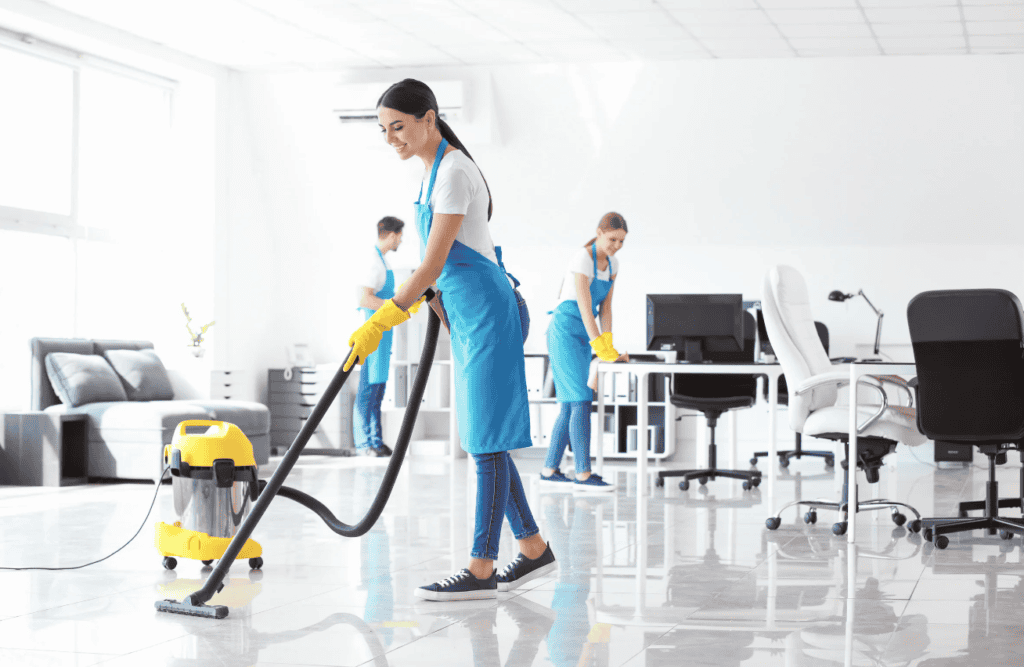In the bustling world of business, attention often gravitates towards overt costs—those expenses that loudly demand our consideration, like rent, salaries, and inventory. However, lurking beneath these apparent expenditures lie the often-overlooked aspects of business operations, particularly in the realm of hygiene and cleaning.
Table of Contents
This segment of business management, though seemingly mundane, carries with it hidden costs and complexities that can significantly impact a company’s bottom line and reputation.
From the procurement of cleaning supplies to the employment of janitorial services, managing these costs efficiently requires insight, strategy, and an understanding of their long-term business implications.

Understanding the Importance of Hygiene and Cleaning in the Workplace
Creating a clean and healthy work environment is crucial not only for the well-being of employees but also for maintaining a professional business image. A tidy workplace enhances productivity and reduces the risk of sickness spreading among staff, which can lead to costly absences.
Additionally, clients’ and visitors’ first impressions are often influenced by the cleanliness of your space, affecting their willingness to do business with you.

Investing in quality cleaning services and supplies is a proactive measure that can save businesses considerable money in the long run. By preventing the spread of diseases, companies can minimize the number of sick days taken by employees, thereby ensuring that the workflow remains uninterrupted and productivity levels stay high.
Plus, hygiene services can also reduce the need for costly repairs or replacements caused by neglecting regular cleaning and maintenance. This makes it a cost-effective investment in the overall health and functionality of your business.
The Cost of Cleaning Supplies
Securing cleaning supplies is a more complex process than it initially appears, largely due to the vast range of products available and the varying needs of businesses. Companies must carefully select supplies that not only effectively clean and sanitize but also align with their operational budget and environmental values.
The cost of cleaning supplies is affected by factors such as the quality of the products, the quantity purchased at a time, and whether a business opts for eco-friendly solutions, which can be more expensive upfront but potentially save money and contribute to corporate social responsibility efforts in the long run.
In addition to the direct costs of purchasing cleaning supplies from the Global Industrial Company, businesses must also consider the efficiency and effectiveness of these products.
Investing in higher-quality, concentrated cleaning solutions can lead to long-term savings by reducing the amount needed for each cleaning, thus lowering the overall frequency of purchase.
Additionally, training staff on the proper use of these supplies can prevent waste and ensure that the investment in cleaning products translates directly into a cleaner, healthier work environment.
The strategic selection and management of cleaning supplies, therefore, become crucial elements in controlling the hidden costs associated with maintaining workplace hygiene.
Outsourcing vs. In-House Cleaning Staff
Determining whether to outsource cleaning services or maintain an in-house team presents a significant decision for businesses, impacting both financial and operational aspects of workplace hygiene management.
Outsourcing can offer flexibility and reduce the responsibilities of managing an in-house team, such as recruitment, training, and payroll, which itself can be a considerable hidden cost.
Professional cleaning companies bring expertise, efficiency, and the latest cleaning technologies, potentially leading to higher cleaning standards and compliance with health regulations.
However, this convenience comes at a premium, and companies must weigh the ongoing expense against the benefits of having a dedicated team at their service, which can be particularly valuable for businesses with specialized cleaning needs or those operating in sectors where cleanliness is paramount.
On the other hand, developing an in-house cleaning team allows for greater control over cleaning schedules, the selection of cleaning products, and the adaptability to immediate cleaning needs.
It can promote a sense of loyalty and familiarity, where the staff understands the specific needs and priorities of the business. Initial costs include hiring, training, and purchasing equipment, but it enables a more personalized approach to maintaining cleanliness standards.
Financially, it might offer long-term savings by avoiding the premium prices of outsourcing and allowing businesses to negotiate directly for supplies at wholesale prices.
Regardless of the chosen route, the key is to ensure that the decision aligns with the company’s operational requirements, budget, and overarching goals for workplace hygiene and employee health.
Frequency of Cleaning
Determining the optimal frequency of cleaning is an essential part of hygiene and cost management for any business. This decision is influenced by several factors, including the nature of the business, the amount of foot traffic, and specific industry regulations.
For example, a healthcare facility or a food service business will have stringent cleaning requirements to prevent contamination and illness, necessitating multiple cleanings per day. In contrast, a small office space might require less frequent attention, depending on staff numbers and common area usage.
The goal is to strike a balance between maintaining a clean, healthy environment and managing the financial outlay effectively. Regularly assessing the cleaning needs and adjusting the schedule as necessary can lead to improved efficiency and cost savings over time.
Integrating technology and adopting innovative cleaning strategies can play a pivotal role in optimizing cleaning schedules and processes.
Smart cleaning technologies, such as IoT-enabled devices and AI-driven scheduling systems, can help businesses monitor their environments and plan cleaning operations more effectively.
These tools can track high-traffic areas, usage patterns, and supply levels, enabling precise scheduling and supply management. Not only does this approach enhance the cleanliness and safety of the workplace, but it also contributes to more sustainable operations by reducing waste and conserving resources.
In an era where efficiency and sustainability are highly valued, leveraging technology in cleaning operations is an investment that can yield significant returns in terms of cost savings, environmental responsibility, and workplace health.
The Impact of Employee Health and Productivity
The correlation between employee health, productivity, and workplace hygiene cannot be understated. A clean working environment directly contributes to the physical well-being of staff members, reducing the prevalence of allergens, bacteria, and viruses that can cause illness.
This proactive approach to maintaining cleanliness not only minimizes the occurrence of sick days but also boosts morale among the workforce. When employees notice their company’s commitment to their health through rigorous hygiene practices, it fosters a positive work culture, enhancing job satisfaction and loyalty.
Additionally, a healthy staff is inherently more productive, showing improved concentration, fewer errors, and more energy. Thus, by investing in a robust cleaning regimen, businesses are indirectly investing in their most valuable asset: their employees.
The strategic management of workplace hygiene has a broader impact on business operations that extends beyond immediate health benefits. It plays a vital role in shaping the company’s brand image and customer perception.
Clean facilities are often equated with professionalism, attention to detail, and high standards of service, aspects that customers and clients notice and appreciate.
Particularly in industries where trust and cleanliness are paramount, such as hospitality, healthcare, and food service, a reputation for impeccable hygiene can be a significant differentiator in a competitive market.
Hence, the implications of effective hygiene management seep into various facets of a business, underscoring its importance not just for employee welfare but for overall business success and sustainability.
Legal and Regulatory Considerations
Businesses must also be mindful of the legal and regulatory standards regarding workplace hygiene. Failing to meet these standards can result in fines, legal action, and damage to the company’s reputation. Business owners and managers need to stay informed about the hygiene regulations applicable to their industry and region.
Compliance not only protects businesses from legal repercussions but also ensures that employees and customers are in a safe and clean environment. Regular training sessions and updates on these regulations can help maintain high standards of hygiene and protect the business from potential legal issues.
Technology and Innovations in Cleaning
The advancement of technology has introduced new and efficient ways of maintaining cleanliness in the workplace. Automated cleaning devices, eco-friendly cleaning agents, and advanced sanitization techniques can help businesses achieve higher cleanliness standards while potentially reducing long-term costs.
Investing in innovative cleaning technologies can be an excellent strategy for businesses looking to enhance their cleaning efficiency. However, it requires upfront investment and an understanding of which technologies are most effective for their specific needs, balancing innovation with cost implications.
Assessing and Managing Hygiene and Cleaning Efficiency
Regularly assessing the effectiveness of a business’s cleaning strategy is crucial. This can involve soliciting feedback from employees and customers, monitoring health and safety records, and reviewing the costs associated with hygiene and cleaning and maintenance activities.
Through assessment, businesses can identify areas for improvement or adjustment in their cleaning protocols. Strategic management of cleaning processes, informed by regular assessments, allows businesses to maintain high cleanliness standards while controlling costs.
By being proactive and responsive to feedback, companies can ensure that their investment in hygiene and cleaning contributes positively to their bottom line and workplace environment.

In conclusion, effective management of workplace hygiene involves a multifaceted approach that considers the well-being of employees, budget constraints, technological innovations, and legal requirements.
By prioritizing a clean and healthy work environment, businesses can foster a positive organizational culture, enhance productivity, and maintain a competitive edge.
Strategic investments in high-quality cleaning supplies, smart technology, and efficient cleaning services — whether outsourced or in-house — demonstrate a commitment to employee health and environmental sustainability.
Adapting to feedback and evolving standards is essential for continuous improvement in hygiene practices. Ultimately, the meticulous management of workplace cleanliness not only protects a company’s most valuable asset, its people but also contributes to its broader success and reputation.
Hygiene And Cleaning for A Business – FAQs
Q1: How can small businesses afford advanced hygiene and cleaning technologies?
A1: Small businesses can leverage advanced cleaning technologies by considering cost-effective solutions like leasing equipment or opting for scalable services that match their size and needs.
Additionally, prioritizing investments in technologies that offer long-term savings, such as energy-efficient devices, can reduce overall expenses. Government grants or incentives for small businesses to adopt eco-friendly technologies may also be available.
Q2: Is it more cost-effective to outsource hygiene and cleaning services or to have an in-house team?
A2: The cost-effectiveness of outsourcing vs. having an in-house cleaning team depends on various factors, including the size of the business, frequency of cleaning required, and specific cleaning needs.
Outsourcing can offer expertise and flexibility without the overhead costs of managing staff, whereas an in-house team provides more control and can be financially beneficial for larger businesses with daily cleaning needs.
Q3: How frequently should a business deep clean its facilities?
A3: The frequency of deep cleaning depends on the type of business, the amount of foot traffic, and industry regulations. It’s generally recommended to schedule deep cleaning every quarter, but businesses like restaurants, healthcare facilities, and gyms may require more frequent deep cleaning to meet health standards and ensure customer safety.
Q4: How do businesses measure the effectiveness of their hygiene and cleaning routines?
A4: Businesses can measure the effectiveness of their cleaning routines through regular audits, employee feedback, customer satisfaction surveys, and tracking the incidence of hygiene and cleaning issues or complaints.
Additionally, using smart technology to monitor cleanliness and maintenance tasks can provide data-driven insights into the cleaning process’s effectiveness.
Q5: What are the most important legal and regulatory considerations for workplace hygiene?
A5: The most important legal and regulatory considerations include adhering to Occupational Safety and Health Administration (OSHA) guidelines, following industry-specific regulations (such as those for food service or healthcare), and complying with local health and safety standards.
Regular training for staff on compliance matters and staying informed about changes in legislation are key to meeting these considerations.



